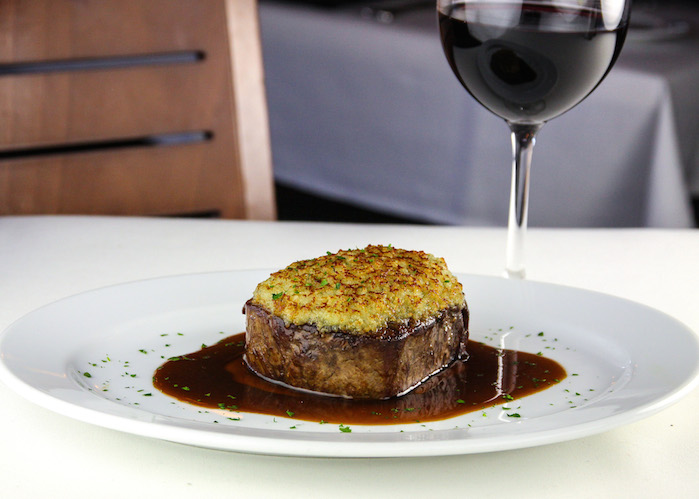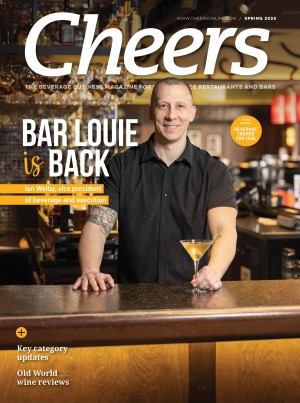Entrepreneur Cameron Mitchell started his hospitality empire in 1993 with Cameron’s restaurant in Columbus, OH. Nearly 25 years later, Cameron Mitchell Restaurants (CMR) has evolved to eight different concepts and 28 units spread over 11 states.
Many of the brands are one-offs located in and near Columbus, such as Molly Woo’s Asian Bistro, Martini Modern Italian and the high-end restaurant M, and a few have two to three locations, such as Cap City Fine Diner and Marcella’s.
The largest brand is Ocean Prime, an upscale seafood/steakhouse concept located in major metropolitan areas. It started out as Mitchell’s Ocean Club in Columbus in 2006; when the brand expanded beyond Ohio two years later, with openings in Troy, MI, Phoenix and Orlando, FL, the company renamed those locations Ocean Prime.

Ryan Valentine, Cameron Mitchell Restaurants director of beverage.
CMR, which sold its Mitchell’s/Cameron’s Steakhouse and Mitchell’s/Columbus Fish Market locations to Ruth’s Chris Steak House in 2008, now operates 14 Ocean Prime units. Locations include Beverly Hills; Boston; Dallas; Denver; Indianapolis; Naples, FL; New York; Philadelphia; Phoenix; Tampa; and Washington, D.C., plus the original Mitchell’s Ocean Club in Columbus.
So what has CMR learned about developing beverage programs for a national brand as well as a diverse collection of regional concepts?
Plenty, says the company’s director of beverage Ryan Valentine. For one thing, menus must be tailored to local tastes. The Ocean Prime in Denver has an international focus and New York is more European in tastes, while locations in California feature more local products and ingredients.
Tequila cocktails are a must-have for the Dallas Ocean Prime; not so much for the Detroit restaurant, which boasts a robust Scotch menu.
Tracking Trends
How does Valentine keep up with what’s popular and where? He and CMR’s beverage operations manager Andrea Hoover for watch trends and try to get ahead of them before they blow up, rather than play catch up.
The two monitor what’s hot in markets such as San Francisco and New York; once a year they visit New York to explore the city’s trends. “We’ll have a dialog about might work where,” Valentine says.

Andrea Hoover, Cameron Mitchell Restaurants beverage operations manager.
For instance, Hoover discovered on a recent New York trip how a touch of salt in cocktails can replace bitters as a flavor enhancer. As a result, many of the backbars of CMR concepts now carry a 20% salt, 80% water solution. “I love it in a Manhattan, or in a clarified mint julep,” she says.
But being too aggressive in adopting trends can occasionally lead to cocktails that are ahead of their time.
For example, when CMR opened the Ocean Prime in Detroit, the drinks menu included a Margarita made smoky with the inclusion of a little Ardberg Scotch. Nine out of 10 customers sent back the cocktail, Valentine recalls. That smoky flavor profile for cocktails has since caught on across the country, thanks to the popularity of mezcal.
Staff-Created Cocktails
Valentine and Hoover also look to bar staff for beverage innovation. Last year they held a cocktail contest in which every Ocean Prime location elected a member of the bar team as their representative.
Each contestant created a cocktail that featured Absolut Elyx vodka and presented it at CMR’s Columbus headquarters. Hoover and several other CMR corporate employees judged the competition.
The winning entry was the Watermelon Elyx, made with Absolut Elyx, Uncle Val’s gin, watermelon purée, basil simple syrup, fresh-squeezed lime juice and Hella Ginger bitters. Created by Maggie Day, lead trainer and bartender for Ocean Prime Indianapolis, the Watermelon Elyx was added to all Ocean Prime menus for a year.
Ocean Prime this year implemented a national program in which each team creates their own Russell’s Reserve bourbon cocktail.
It’s not a contest, though: “We wanted to integrate regional representation by our associates and their tastes,” Valentine says. “We will only help along the development process to ensure it is a high level of quality.”

The Watermelon Elyx, made with Absolut Elyx, Uncle Val’s gin, watermelon purée, basil simple syrup, fresh-squeezed lime juice and Hella Ginger bitters
Balancing Beverage Programs
With such an eclectic collection of concepts, designing and managing beverage programs for each isn’t easy.
“First I think about the cuisine served there, the vibe of the restaurant, and the check average,” explains Valentine. “Those will help determine the personality of the cocktail program and the size of the wine list.”
When helping develop new concepts, Valentine and Hoover will work with the company’s test kitchen. But it’s more than simply matching the food: they pair drinks with the overall look and ambience of the brand. “With this thinking, the cocktails can come out of the concept organically,” Hoover says.
For instance, when designing the cocktail menu for The Guild House restaurant in Columbus, Hoover noted the concept’s unique, rustic-modern space and focus on locally sourced ingredients. She imagined a menu with a “light, spa-fresh quality” and began designing drinks that would simply take on the name of the different spirit they featured.
The result are house cocktails (priced at $10 each) such as Gin: made with The Botanist gin, rosemary, muddled raisins and fresh lemon juice; Rye: with darjeeling tea-infused Bulleit rye, Lillet rouge, Carpano Antica, Angostura bitters; and Cachaça: with Avua cachaça prata, blue curaçao, Suze gentian liqueur, fresh pineapple, lime and passion fruit.
Whiskey Business
Given the popularity of brown spirits, many of the CMR brands offer whiskey menus—some on lengthier side. For instance, The Barn at Rocky Fork Creek in Gahanna, OH, which also includes a rustic bar called The Bourbon Lounge, lists 65 spirits, 11 cocktails and eight flights in its whiskey book.

The Barn at Rocky Fork Creek in Gahanna, OH, which also includes a rustic bar called The Bourbon Lounge, lists 65 spirits, 11 cocktails and eight flights in its whiskey book.
The Barn’s whiskey list breaks down into the three main American takes on the spirit: bourbon, rye and Tennessee whiskey. Each entry includes a description with flavor notes, aging, ABV and mash bill. The menu is mostly Kentucky and Tennessee brands: Basil Hayden’s ($10.75), Booker’s ($11.50), Four Roses Single Barrel ($12), Knob Creek rye ($10), Russell’s Reserve rye ($10), Gentleman Jack ($10), Prichard’s ($10.50). A handful from other states include Hudson Manhattan rye ($13), Cleveland Whiskey bourbon ($9.50) and Oyo Michelone Reserve ($10) of Columbus, OH.
“Mostly any whiskeys you can find in Ohio are on there,” says Valentine. “The selection is about as good as you can get.”
Which is not easy, because Ohio is a control state, “so it can be quite challenging getting certain things,” adds Hoover. “We have a plethora of spirits that have become next to impossible to allocate,” including Domaine de Canton, Crème Yvette, Don Pancho and Luxardo.
The Barn employees collaborated with Woodford Reserve on two whiskeys, a blend and a single-barrel, both unique to the restaurant: Woodford Reserve Barn No. 5 ($11) and Woodford Reserve Double Oak Single Barrel ($12).
Woodford Reserve is also featured in four bourbon cocktails: Barn Tea ($10.50), with chamomile tea, fresh mint and lime; Bourbon and Citrus ($10.50), with fresh orange and lime juice, cinnamon simple syrup and Angostura bitters; Bourbon Apple Punch ($11), with Double Oak bourbon, Calvados, velvet falernum, orgeat, lemon, Old Fashioned bitters; and the Bourbon Hemingway ($11.50), with Double Oak bourbon, Luxardo maraschino liqueur, fresh grapefruit and lime.
The Barn also offers seven different bourbon flights. “I never thought we’d see flights selling like they do, but they sell well enough to be in the top-10 spirit mix there,” Valentine says. “You always have to look into anything that keeps people exploring different types of whiskey.”

The Barn offers barrel-aged Manhattan cocktails.
The concept’s list also includes three barrel-aged Manhattan cocktails ($10.50 each) that take their name from the style of whiskey used: Tennessee, Kentucky and Rye. The three cocktails came out so differently that CMR decided to do offer a Manhattan flight for $15, Hoover says.
Wine for Everyone
When designing a wine list, Valentine and Hoover keep guest experience at the forefront of their decisions. A diverse selection is critical to best accommodate people of all tastes and levels of knowledge.
One customer will be attracted to a familiar California winery such as Sterling; another will want an artisanal, small- production wine from an offbeat appellation. The key is to have a bit of both, and a little of everything in between.
“Everyone views the wine list differently,” Hoover says. “My favorite wines might not be their favorites, because they’re not well rounded enough. At the same time, we don’t want to be too obvious with all our wines.”
Ocean Prime in New York, for instance, lists more than 275 wines, including 56 by-the-glass pours, categorized simply by sparkling, red and white wines. The bottle list is more granularly separated: sparkling whites, New and Old World chardonnay, sauvignon blanc, selected whites, selected reds, Italian reds, merlot, New and Old World pinot noir, cabernet sauvignon and blends and Spanish reds.
The wine selection includes the restaurant’s “Prime List.” These are 58 premium bottles, priced accordingly, such as Dom Pérignon Champagne 2005 ($1,450), Château Margaux 2006 ($1,550) and Penfolds “Grange” shiraz ($1,895) and more. Prime List wines range from $50 to $2,575, with most priced $100 to $400.
Valentine believes in offering a robust by-the-glass wine program. “If a guest walks in and wants a nice glass of Champagne with the raw bar, or a nice glass of red with their steak, they should be able to get those nice wines without having to commit to a bottle decision.”

Valentine believes in offering a robust by-the-glass wine program. “If a guest walks in and wants a nice glass of Champagne with the raw bar, or a nice glass of red with their steak, they should be able to get those nice wines without having to commit to a bottle decision.”
To offer higher-quality wine by the glass, CMR restaurants began using the Coravin system in August 2016. Coravin uses a needle through the cork to access the wine and then replaces the withdrawn wine with argon gas.
The wine in the bottle isn’t exposed to oxygen so it keeps longer. Staffers also pay close attention to bottles that have been opened, monitoring their freshness and flavor.
At the Ocean Prime in New York, the menu highlights four by-the-glass premium wines available thanks to Coravin: Rochioli pinot noir 2014 ($40), Il Poggione Brunello di Montalcino 2011 ($45), Chimney Rock cabernet sauvignon ($42) and Jordan cabernet sauvignon ($36).
Coravin hasn’t necessarily changed the amount of wines offered by the glass, Valentine says, “but it has given us more flexibility to add different pedigree wines and wines that are more interesting to a specific market.”
Beer Today
When constructing a beer menu, Valentine starts fresh by considering how many taps a bar will have, and the range of that restaurant’s guests. Some places tend to attract more cerebral beer enthusiasts, but still must include a selection with something for everyone.
Take the Pearl, a CMR scratch-food gastropub in Columbus, as an example. The eight tap handles will include easy-drinking staples such as Lagunitas IPA ($6.50) and Ballast Point California Amber ($7), and also the local, high-concept brews that attract craft-beer nerds, such as Pearl Oyster Stout ($7) from North High Brewing in Columbus.
The Pearl also boasts a 36-beer bottle list. Novice drinkers will find the familiar likes of Brooklyn Lager ($5.50) and Stone IPA ($5). Craft brew fans can choose from a diverse selection of wheats, ciders and fruit beers to dark ales and Belgian imports.
Guests can splurge on a 22-oz. bottle of Dragon’s Milk Oak Barrel American Stout ($18) or a 375-ml. of De Troch Oude Gueuz ($12).
At places with smaller beer menus, fewer taps and less of a craft focus, Valentine first includes a macro light beer. Then he’ll add the area’s leading import and a local seasonal.
One beer needs to be an IPA, but Valentine cautious against overdoing menus with regional and craft beer. “Some people do not get excited about craft,” he says. “And it’s still only 14% of beer sold that’s craft. Like with the wine list, you don’t want to have anyone who cannot find a beer that they would want.”
The flexibility afforded to each concept’s beverage team to pick and pour local beers depends on that brand. A trendy gastropub like The Pearl obviously would have a longer leash than the sit-down luxury of the multi-unit Ocean Prime.

The Pearl, a CMR scratch-food gastropub in Columbus, has a beer menu befitting the craft brew fans who live in the area.
Investing in People
Training staff, retaining and promoting talent is a core competency of CMR. Valentine says that Cameron Mitchell fast-tracked his career after seeing something in a brash young bartender who started in 1993 when the first Cameron’s restaurant opened.
Valentine in turn elevated Hoover after she impressed him with her people skills and ambition. Hired as a server at M in 2012, Hoover was promoted to her current position in 2015.
“She’s the perfect person for this role,” Valentine says of Hoover. “She brings a focus on collaboration, and she’s always continuing to evolve.”
Employee development is key to enhancing the guest experience at any concept. “If I go into one of our restaurants and they have four IPAs on tap, that’s a teaching opportunity for me,” Valentine says.
“I remind them that we’re not making decisions based on what we like, but what can best appeal to the range of guests who come into that restaurant.”
Kyle Swartz is managing editor of Cheers magazine. Reach him at kswartz@epgmediallc.com or on Twitter @kswartzz. Read his recent piece 10 Beverage Trends to Watch in 2017-18.








